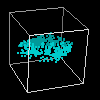
Astronomy and Astrophysics
Friday
Home
Links
Glossary
Monday
Tuesday
Wednesday
Thursday
Friday
Create Report
Projects
Today you will present the results of your research in a symposium to your colleagues and the Shodor staff. The recommended package for doing your presentations is PowerPoint. Consider the following tips in your presentation.
- Typical scientific talks follow the IMRD format. Introduction, Method, Results, Discussion.
- Don't try to cram too much information on each slide, and don't read directly from them. The slides are there to help you, you are not there to help the slides.
- Do use visual aids. Visual aids should be visual. Recommended graphics are a diagram of your model, or a graph or visualization of your results.
- Don't put unnecessary artwork or use many different transitions. It is distracting from your talk. If any artwork is used, it is best to have the same artwork on each page to create a consistent look and feel. If any slide transitions are used, you should use the same ones throughout the talk.
- Do pause occasionally to let what you are saying sink in, and to give the audience a chance to ask questions.
- Do ask the audience if they have any questions.
- Don't make up answers to questions you don't know. No speaker knows the answer to every question, and there is no shame in saying you don't know.
- Do try to give as much information as you can when you do not know an answer. Suggesting where to look for information, or talking about a slightly different situation that might apply can often be helpful.
- Don't put unnecessary sound in your presentation. It distracts the audience, and makes it more difficult for you to be heard over the noise.
- Be sure to talk to the audience, not the screen.
- Practice the talk ahead of time.
- Have fun! If you are prepared, public speaking can be a pleasant and rewarding experience. People are taking the class because they want to learn, and they want to hear what you have to say.